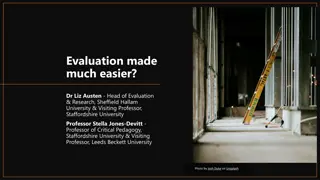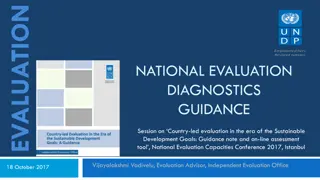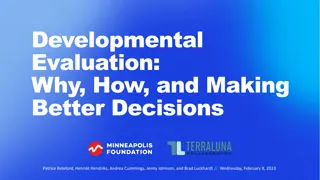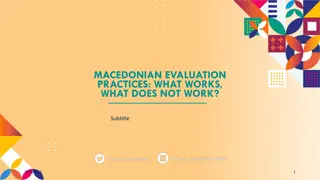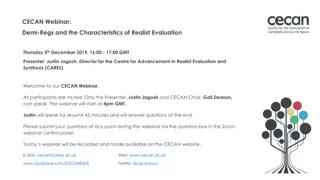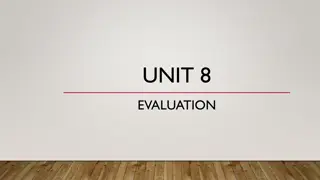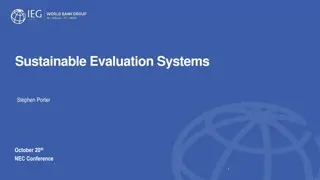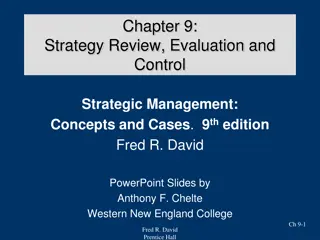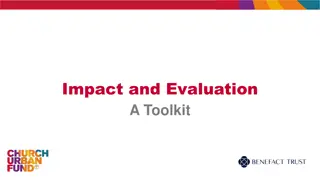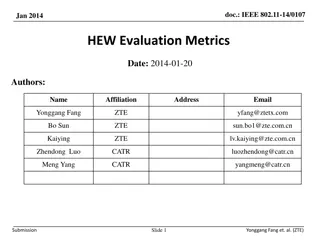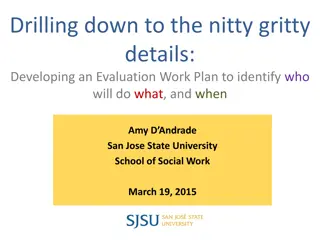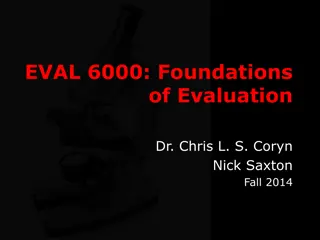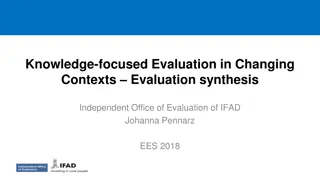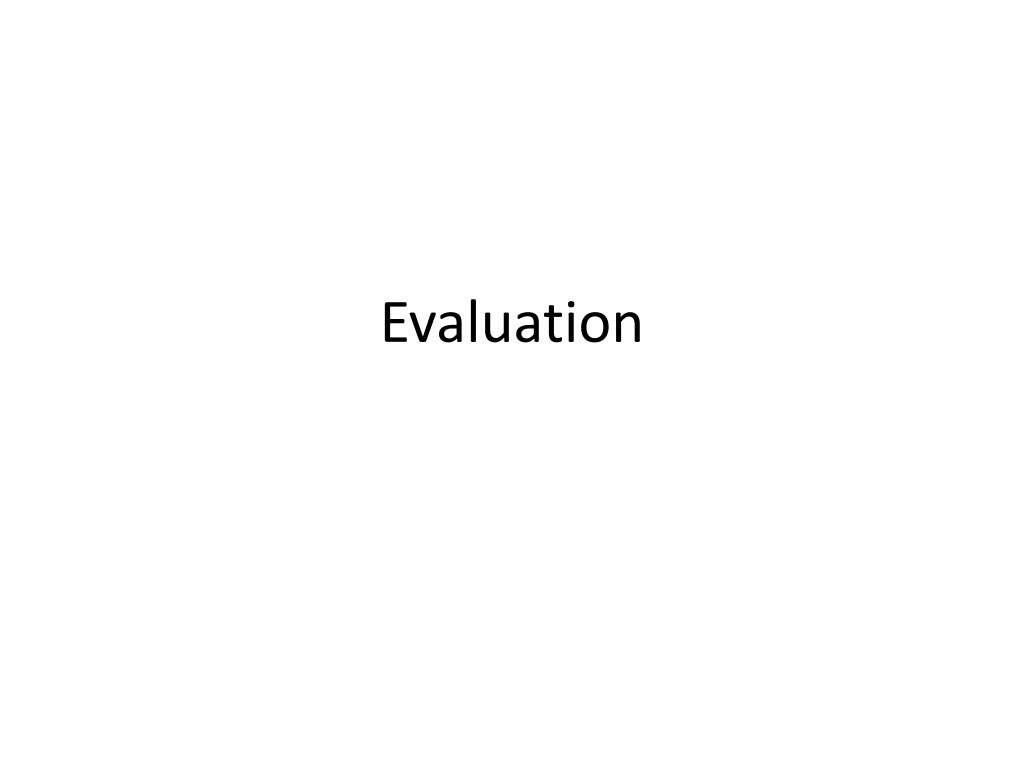
Effective Computer Science Evaluation Methods and Techniques
Enhance your knowledge of evaluation techniques in computer science to address critical questions in your field. Explore a variety of methods, including computation, testing, and human-subject evaluation, to ensure the success of your projects and initiatives.
Download Presentation

Please find below an Image/Link to download the presentation.
The content on the website is provided AS IS for your information and personal use only. It may not be sold, licensed, or shared on other websites without obtaining consent from the author. Download presentation by click this link. If you encounter any issues during the download, it is possible that the publisher has removed the file from their server.
E N D
Presentation Transcript
Computer Science Evaluation Methods Computer science is a broad field so you probably have heard different activities be associated with evaluation. When you graduate, you should know a range of evaluation techniques that you can apply to questions important to your work.
Some CS Evaluation Methods Can this be computed? How much time/memory will be used? Proofs in computability and algorithm analysis Does this implementation meet the specifications? Testing in software engineering How often will this give a correct output? Ground truth comparison, simulation and statistical analysis What are effects of the use of this software? Human-subject testing
Human-Subject Evaluation Methods Why do we evaluate? To learn what works? But there are many metrics Efficiency (time to perform task, tasks per unit time) Effectiveness (quality of result, error rate) Satisfaction (user perception of process/results) Characteristics of evaluation techniques Experiments vs. observations vs. professional analyses Quantitative vs. qualitative
Step 1: Hypothesis for Evaluation Hypothesis Every design has numerous hypotheses you will need to decide on a couple that match topic of this class E.g., does it improve awareness, communication, or coordination Evaluation can include both specific and general hypotheses E.g., users are more satisfied with the group process But do not just do a general did you like it study
Step 2: Evaluation Type Evaluation categories Experiment tends to bring users to the software Enables collection and comparison of quantitative data Tasks and environment controlled Field study tends to give the software to the users Enables qualitative observations/feedback based on real-world scenarios Cannot control tasks or environment Additional options (will be discussed later) Inspection method Predictive modeling The question being asked often indicates the appropriate evaluation method Mixed methods studies collect both quantitative and qualitative data and triangulate an interpretation or result
Step 3: Participant Selection Ideally, participants would be a representative subset of the intended users In practice, this is very hard to achieve Finding participants that share traits with user population In a study of software aimed at science teachers, having university students in engineering and science majors may be more practical Population of convenience A set of people that is more readily available
Step 3: Participant Selection (cont.) Issues in participant selection Wrong age groups Wrong education/experience Wrong motivations Compare two populations of convenience University community undergraduate and graduate students, staff, faculty Crowdsourcing workers tend to be technically competent and not overly busy with work, etc. Each is better for some types of domains and hypotheses
Step 4: Activity for Participants Determine the activity based on each of the hypotheses being evaluated Does the hypothesis include the whole activity being supported by your software or only a portion of it? Does it take place over time or across users? Anticipate (or co-design) the type of data you will need for evaluation
Step 5: Data Collection Techniques Logging of activity in software Can easily be misinterpreted E.g., quantity of communication Participant feedback after use Need to understand biases
Bias in Data from Participant Reports Courtesy bias tendency to withhold criticism Acquiescence bias tendency to say yes Social desirability bias tendency to avoid reporting features deemed socially undesirable There are other types of reporting biases
Human-Subject Experiments Predict the relationship between two or more variables. Independent variable (e.g. which design) is manipulated by the researcher. Dependent variable (e.g. time) depends on the independent variable. Typical experimental designs have one or two independent variable.
Experimental Designs Different participants - single group of participants is allocated randomly to the experimental conditions. Same participants - all participants appear in both conditions. Matched participants - participants are matched in pairs, e.g., based on expertise, gender, etc.
Different, Same, Matched Participant Design Design Advantages Disadvantages Different No order effects Many subjects & individual differences a problem Same Few individuals, no individual differences Counter-balancing needed because of ordering effects Matched Same as different participants but individual differences reduced Cannot be sure of perfect matching on all differences
The Need to Balance Balancing is equally representing features of the evaluation space (e.g. tasks, designs) Why do we balance For learning effects and fatigue For interactions among conditions For unexpected features of tasks (e.g. difficulty) Latin square study design Used to balance conditions and ordering effects Consider balancing use of two systems for two tasks for a same-participant study
Review of Experimental Statistics For normal distributions T test: for identifying differences between two independent populations Paired T test: for identifying differences between the same population or a well-matched pair of populations ANOVA: for identifying differences between more than two populations There are non-normal versions of all of these tests For predicted distributions Chi square: to determine if difference from predicted is meaningful
Field Studies Field studies are done in natural settings. The aim is to understand what users do naturally and how technology impacts them. Field studies can be used in product design to: - identify opportunities for new technology; - determine design requirements; - decide how best to introduce new technology; - evaluate technology in use.
Field Study Data & Analysis Observation & interviews Notes, pictures, recordings Video Logging, diary studies Analyses Categorized Categories can be provided by theory Grounded theory Activity theory
Other Evaluation Methods Sometimes participants/time/money/etc. are not available in the amount needed Or the goal is to identify issues with a design and potential improvements rather than to evaluate a hypothesis Inspection methods Heuristic evaluation Cognitive walkthroughs Predictive models Use of models of human behaviour to assess/compare
Inspection Methods Experts use their knowledge of users & technology to review software usability Expert critiques (crits) can be formal or informal reports Two main categories: Heuristic evaluation is a review guided by a set of heuristics Walkthroughs involve stepping through a pre- planned scenario noting potential problems
Heuristic Evaluation Developed Jacob Nielsen in the early 1990s. Based on heuristics distilled from an empirical analysis of 249 usability problems These heuristics have been revised for current technology Heuristics being developed for mobile devices, wearables, virtual worlds, etc. Design guidelines form a basis for developing heuristics
Nielsens heuristics Visibility of system status Match between system and real world User control and freedom Consistency and standards Error prevention Recognition rather than recall Flexibility and efficiency of use Aesthetic and minimalist design Help users recognize, diagnose, recover from errors Help and documentation
Discount Evaluation Heuristic evaluation is referred to as discount evaluation when ~5 evaluators are used. Empirical evidence suggests that on average 5 evaluators identify 75-80% of usability problems.
3 stages for doing heuristic evaluation Briefing session to tell experts what to do Evaluation period of 1-2 hours in which: Each expert works separately Take one pass to get a feel for the product Take a second pass to focus on specific features Debriefing session in which experts work together to prioritize problems
Cognitive Walkthroughs Focus on ease of learning Designer presents an aspect of the design & usage scenarios Expert is told the assumptions about user population, context of use, task details One of more experts walk through the design prototype with the scenario Experts are guided by 3 questions
The 3 questions Will the correct action be sufficiently evident to the user? Will the user notice that the correct action is available? Will the user associate and interpret the response from the action correctly? Note the connection to Norman s gulf of execution and gulf of evaluation. As the experts work through the scenario they note problems.
Pluralistic walkthrough Variation on the cognitive walkthrough theme. Performed by a carefully managed team. The panel of experts begins by working separately. Then there is managed discussion that leads to agreed decisions. The approach lends itself well to participatory design.
Inspection Methods: Advantages and Problems Few ethical & practical issues to consider because users not involved Can be difficult & expensive to find experts Best experts have knowledge of application domain & users Biggest problems: Important problems may get missed Many trivial problems are often identified Experts have biases
Predictive Models Provide a way of evaluating products or designs without directly involving users Less expensive than user testing Usefulness limited to systems with predictable tasks - e.g., telephone answering systems, mobiles, cell phones, etc. Most models make predictions based on expert error-free behavior
GOMS Goals - the state the user wants to achieve e.g., find a website. Operators - the cognitive processes & physical actions needed to attain the goals, e.g., decide which search engine to use. Methods - the procedures for accomplishing the goals, e.g., drag mouse over field, type in keywords, press the go button. Selection rules - decide which method to select when there is more than one. Use at NYNEX and NASA
Keystroke level model GOMS has also been developed to provide a quantitative model - the keystroke level model. The keystroke model allows predictions to be made about how long it takes an expert user to perform a task.
Response times for keystroke level operators (Card et al., 1983) Operator K Description Pressing a single key or button Average skilled typist (55 wpm) Average non-skilled typist (40 wpm) Pressing shift or control key Typist unfamiliar with the keyboard Pointing with a mouse or other device on a display to select an object. This value is derived from Fitts Law which is discussed below. Clicking the mouse or similar device Bring home hands on the keyboard or other device Mentally prepare/respond The response time is counted only if it causes the user to wait. Time (sec) 0.22 0.28 0.08 1.20 0.40 P P1 H 0.20 0.40 M R(t) 1.35 t
Fitts Law (Fitts, 1954) Fitts Law predicts that the time to point at an object using a device is a function of the distance from the target object & the object s size. The further away & the smaller the object, the longer the time to locate it and point to it. Fitts Law is useful for evaluating software for which the time to locate and move to an object is important.
Characteristics of approaches Experiment Field studies natural Inspection Users do task not involved Location controlled natural anywhere When prototype Early or late prototype Data Mostly quantitative measures & errors applied Traditionally qualitative descriptions problems Feed back problems Type naturalistic expert




